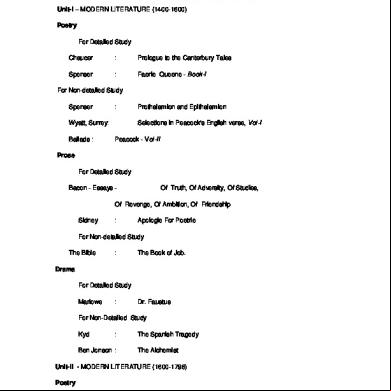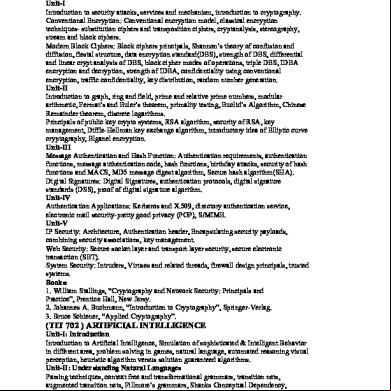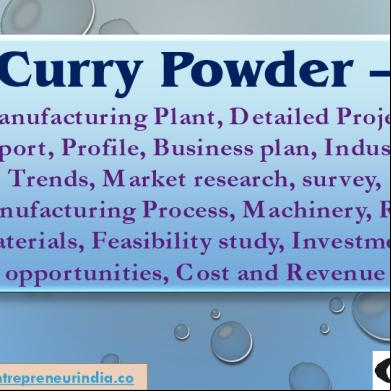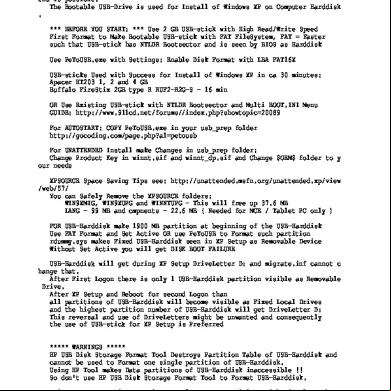Syllabus 4eb60
This document was ed by and they confirmed that they have the permission to share it. If you are author or own the copyright of this book, please report to us by using this report form. Report 2z6p3t
Overview 5o1f4z
& View Syllabus as PDF for free.
More details 6z3438
- Words: 947
- Pages: 3
(TIT 701 ) CRYPTOGRAPHY AND NETWORK SECURITY Unit-I Introduction to security attacks, services and mechanism, introduction to cryptography. Conventional Encryption: Conventional encryption model, classical encryption techniques- substitution ciphers and transposition ciphers, cryptanalysis, stereography, stream and block ciphers. Modern Block Ciphers: Block ciphers principals, Shannon’s theory of confusion and diffusion, fiestal structure, data encryption standard(DES), strength of DES, differential and linear crypt analysis of DES, block cipher modes of operations, triple DES, IDEA encryption and decryption, strength of IDEA, confidentiality using conventional encryption, traffic confidentiality, key distribution, random number generation. Unit-II Introduction to graph, ring and field, prime and relative prime numbers, modular arithmetic, Fermat’s and Euler’s theorem, primality testing, Euclid’s Algorithm, Chinese Remainder theorem, discrete logarithms. Principals of public key crypto systems, RSA algorithm, security of RSA, key management, Diffle-Hellman key exchange algorithm, introductory idea of Elliptic curve cryptography, Elganel encryption. Unit-III Message Authentication and Hash Function: Authentication requirements, authentication functions, message authentication code, hash functions, birthday attacks, security of hash functions and MACS, MD5 message digest algorithm, Secure hash algorithm(SHA). Digital Signatures: Digital Signatures, authentication protocols, digital signature standards (DSS), proof of digital signature algorithm. Unit-IV Authentication Applications: Kerberos and X.509, directory authentication service, electronic mail security-pretty good privacy (PGP), S/MIME. Unit-V IP Security: Architecture, Authentication header, Encapsulating security payloads, combining security associations, key management. Web Security: Secure socket layer and transport layer security, secure electronic transaction (SET). System Security: Intruders, Viruses and related threads, firewall design principals, trusted systems. Books: 1. William Stallings, “Cryptography and Network Security: Principals and Practice”, Prentice Hall, New Jersy. 2. Johannes A. Buchmann, “Introduction to Cryptography”, Springer-Verlag. 3. Bruce Schiener, “Applied Cryptography”.
(TIT 702 ) ARTIFICIAL INTELLIGENCE Unit-I: Introduction Introduction to Artificial Intelligence, Simulation of sophisticated & Intelligent Behavior in different area, problem solving in games, natural language, automated reasoning visual perception, heuristic algorithm versus solution guaranteed algorithms. Unit-II: Understanding Natural Languages Parsing techniques, context free and transformational grammars, transition nets, augmented transition nets, Fillmore’s grammars, Shanks Conceptual Dependency, grammar free analyzers, sentence generation, and translation.
Unit-III: Knowledge Representation First order predicate calculus, Horn Clauses, Introduction to PROLOG, Semantic Nets Partitioned Nets, Minskey frames, Case Grammar Theory, Production Rules Knowledge Base, The Inference System, Forward & Backward Deduction. Unit-IV: Expert System Existing Systems (DENDRAL, MYCIN), domain exploration, Meta Knowledge, Expertise Transfer, Self Explaining System. Unit-V: Pattern Recognition Introduction to pattern Recognition, Structured Description, Symbolic Description, Machine perception, Line Finding, Interception, Semantic, & Model, Object Identification, Speech Recognition. Programming Language: Introduction to programming Language, LISP, PROLOG Books: 1. Charnick “Introduction to Artificial Intelligence.” Addision Wesley 2. Rich & Knight, “Artificial Intelligence” 3. Winston, “LISP”, Addison Wesley 4. Marcellous, “Expert Systems Programming”, PHI 5. Elamie.” Artificial Intelligence, “Academic Press 6. Lioyed, Foundation of Logic Programming,”Springer Verlag
(TIT 012 ) MULTIMEDIA SYSTEMS Unit-I: Introduction Introduction to Multimedia, Multimedia Information, Multimedia Objects, Multimedia in business and work. Convergence of Computer, Communication and Entertainment products Stages of Multimedia Projects Multimedia hardware, Memory & storage devices, Communication devices, Multimedia software's, presentation tools, tools for object generations, video, sound, image capturing, authoring tools, card and page based authoring tools. Unit-II: Multimedia Building Blocks Text, Sound MIDI, Digital Audio, audio file formats, MIDI under windows environment Audio & Video Capture. Unit-III: Data Compression Huffman Coding, Shannon Fano Algorithm, Huffman Algorithms, Adaptive Coding, Arithmetic Coding Higher Order Modelling. Finite Context Modelling, Dictionary based Compression, Sliding Window Compression, LZ77, LZW compression, Compression, Compression ratio loss less & lossy compression. Unit-IV: Speech Compression & Synthesis Digital Audio concepts, Sampling Variables, Loss less compression of sound, loss compression & silence compression. Unit-V: Images Multiple monitors, bitmaps, Vector drawing, lossy graphic compression, image file formatic animations Images standards, JPEG Compression, Zig Zag Coding, Multimedia Database.Content based retrieval for text and images,Video:Video representation, Colors, Video Compression, MPEG standards, MHEG Standard Video Streaming on net, Video Conferencing, Multimedia Broadcast Services, Indexing and retrieval of Video Database, recent development in Multimedia. Books:
1. Tay Vaughan “Multimedia, Making IT Work” Osborne McGraw Hill. 2. Buford “Multimedia Systems” Addison Wesley. 3. Agrawal & Tiwari “Multimedia Systems” Excel. 4. Mark Nelson “Data Compression Book” BPB. 5. David Hillman “Multimedia technology and Applications” Galgotia Publications. 6. Rosch “Multimedia Bible” Sams Publishing. 7. Sleinreitz “Multimedia System” Addison Wesley. 8. James E Skuman “Multimedia in Action” Vikas.
(TCS 034 ) DATA COMPRESSION Unit - I: Introduction Compression Techniques: Loss less compression, Lossy Compression, Measures of prefonnance, Modeling and coding, Mathematical Preliminaries for Lossless compression: A brief introduction to information theory, Models: Physical models, Probability models, Markov models, composite source model, Coding: uniquely decodable codes, Prefix codes. Unit – II: Huffman coding The Huffman coding algorithm: Minimum variance Huffman codes, Adaptive Huffman coding: Update procedure, Encoding procedure, Decoding procedure. Golomb codes, Rice codes, Tunstall codes, Applications of Hoffman coding: Loss less image compression, Text compression, Audio Compression. Unit-III: Arithmetic Coding Coding a sequence, Generating a binary code, Comparison of Binary and Huffman coding, Applications: Bi-level image compression-The JBIG standard, JBIG2, Image compression. Dictionary Techniques: Introduction, Static Dictionary: Diagram Coding, Adaptive Dictionary. The LZ77 Approach, The LZ78 Approach, Applications: File Compression-UNIX compress, Image Compression: The Graphics Interchange Format (GIF), Compression over Modems: V.42 bits, Predictive Coding: Prediction with Partial match (ppm): The basic algorithm, The ESCAPE SYMBOL, length of context, The Exclusion Principle, The BurrowsWheeler Transform: Move-to-front coding, CALIC, JPEG-LS, Multi-resolution Approaches, Facsimile Encoding, Dynamic Markoy Compression. Unit – IV: Mathematical Preliminaries for Lossy Coding Distortion criteria, Models, Scalar Ouantization: The Quantization problem, Uniform Quantizer, Adaptive Quantization, Non uniform Quantization. Unit-V: Vector Quantization Advantages of Vector Quantization over Scalar Quantization, The Linde-BuzoGray Algorithm, Tree structured Vector Quantizers. Structured Vector Quantizers.
Wish u a very very Happy b'day .......may god bless u........ur gift is attached with it......i guess u'll like it....:)........and waitng for my treat...:P
(TIT 702 ) ARTIFICIAL INTELLIGENCE Unit-I: Introduction Introduction to Artificial Intelligence, Simulation of sophisticated & Intelligent Behavior in different area, problem solving in games, natural language, automated reasoning visual perception, heuristic algorithm versus solution guaranteed algorithms. Unit-II: Understanding Natural Languages Parsing techniques, context free and transformational grammars, transition nets, augmented transition nets, Fillmore’s grammars, Shanks Conceptual Dependency, grammar free analyzers, sentence generation, and translation.
Unit-III: Knowledge Representation First order predicate calculus, Horn Clauses, Introduction to PROLOG, Semantic Nets Partitioned Nets, Minskey frames, Case Grammar Theory, Production Rules Knowledge Base, The Inference System, Forward & Backward Deduction. Unit-IV: Expert System Existing Systems (DENDRAL, MYCIN), domain exploration, Meta Knowledge, Expertise Transfer, Self Explaining System. Unit-V: Pattern Recognition Introduction to pattern Recognition, Structured Description, Symbolic Description, Machine perception, Line Finding, Interception, Semantic, & Model, Object Identification, Speech Recognition. Programming Language: Introduction to programming Language, LISP, PROLOG Books: 1. Charnick “Introduction to Artificial Intelligence.” Addision Wesley 2. Rich & Knight, “Artificial Intelligence” 3. Winston, “LISP”, Addison Wesley 4. Marcellous, “Expert Systems Programming”, PHI 5. Elamie.” Artificial Intelligence, “Academic Press 6. Lioyed, Foundation of Logic Programming,”Springer Verlag
(TIT 012 ) MULTIMEDIA SYSTEMS Unit-I: Introduction Introduction to Multimedia, Multimedia Information, Multimedia Objects, Multimedia in business and work. Convergence of Computer, Communication and Entertainment products Stages of Multimedia Projects Multimedia hardware, Memory & storage devices, Communication devices, Multimedia software's, presentation tools, tools for object generations, video, sound, image capturing, authoring tools, card and page based authoring tools. Unit-II: Multimedia Building Blocks Text, Sound MIDI, Digital Audio, audio file formats, MIDI under windows environment Audio & Video Capture. Unit-III: Data Compression Huffman Coding, Shannon Fano Algorithm, Huffman Algorithms, Adaptive Coding, Arithmetic Coding Higher Order Modelling. Finite Context Modelling, Dictionary based Compression, Sliding Window Compression, LZ77, LZW compression, Compression, Compression ratio loss less & lossy compression. Unit-IV: Speech Compression & Synthesis Digital Audio concepts, Sampling Variables, Loss less compression of sound, loss compression & silence compression. Unit-V: Images Multiple monitors, bitmaps, Vector drawing, lossy graphic compression, image file formatic animations Images standards, JPEG Compression, Zig Zag Coding, Multimedia Database.Content based retrieval for text and images,Video:Video representation, Colors, Video Compression, MPEG standards, MHEG Standard Video Streaming on net, Video Conferencing, Multimedia Broadcast Services, Indexing and retrieval of Video Database, recent development in Multimedia. Books:
1. Tay Vaughan “Multimedia, Making IT Work” Osborne McGraw Hill. 2. Buford “Multimedia Systems” Addison Wesley. 3. Agrawal & Tiwari “Multimedia Systems” Excel. 4. Mark Nelson “Data Compression Book” BPB. 5. David Hillman “Multimedia technology and Applications” Galgotia Publications. 6. Rosch “Multimedia Bible” Sams Publishing. 7. Sleinreitz “Multimedia System” Addison Wesley. 8. James E Skuman “Multimedia in Action” Vikas.
(TCS 034 ) DATA COMPRESSION Unit - I: Introduction Compression Techniques: Loss less compression, Lossy Compression, Measures of prefonnance, Modeling and coding, Mathematical Preliminaries for Lossless compression: A brief introduction to information theory, Models: Physical models, Probability models, Markov models, composite source model, Coding: uniquely decodable codes, Prefix codes. Unit – II: Huffman coding The Huffman coding algorithm: Minimum variance Huffman codes, Adaptive Huffman coding: Update procedure, Encoding procedure, Decoding procedure. Golomb codes, Rice codes, Tunstall codes, Applications of Hoffman coding: Loss less image compression, Text compression, Audio Compression. Unit-III: Arithmetic Coding Coding a sequence, Generating a binary code, Comparison of Binary and Huffman coding, Applications: Bi-level image compression-The JBIG standard, JBIG2, Image compression. Dictionary Techniques: Introduction, Static Dictionary: Diagram Coding, Adaptive Dictionary. The LZ77 Approach, The LZ78 Approach, Applications: File Compression-UNIX compress, Image Compression: The Graphics Interchange Format (GIF), Compression over Modems: V.42 bits, Predictive Coding: Prediction with Partial match (ppm): The basic algorithm, The ESCAPE SYMBOL, length of context, The Exclusion Principle, The BurrowsWheeler Transform: Move-to-front coding, CALIC, JPEG-LS, Multi-resolution Approaches, Facsimile Encoding, Dynamic Markoy Compression. Unit – IV: Mathematical Preliminaries for Lossy Coding Distortion criteria, Models, Scalar Ouantization: The Quantization problem, Uniform Quantizer, Adaptive Quantization, Non uniform Quantization. Unit-V: Vector Quantization Advantages of Vector Quantization over Scalar Quantization, The Linde-BuzoGray Algorithm, Tree structured Vector Quantizers. Structured Vector Quantizers.
Wish u a very very Happy b'day .......may god bless u........ur gift is attached with it......i guess u'll like it....:)........and waitng for my treat...:P










